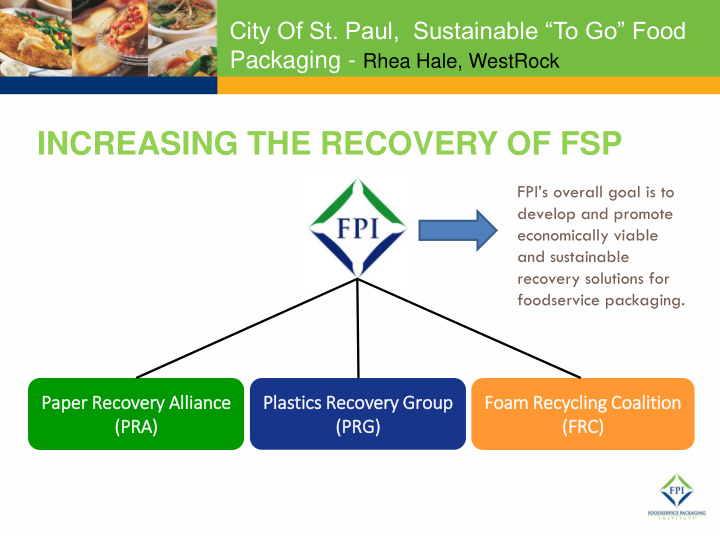



City Of St. Paul, Sustainable “To Go” Food Packaging - Rhea Hale, WestRock INCREASING THE RECOVERY OF FSP FPI’s overall goal is to develop and promote economically viable and sustainable recovery solutions for foodservice packaging. Paper Reco ecovery Allia lliance Pla lasti tics Reco covery Group Foa oam Recy ecycli ling Coa Coali lition (PRA) (P (P (PRG) (FRC) (F
Current PRA and/or PRG Members 2
Where does FSP end up? 3
4 What is Foodservice Packaging? Single-use foodservice ware & packaging used by foodservice establishments . Specifically, our work focuses on : Cups (including sleeves) Containers, including: • Beverage Carriers Boxes Paper bags
How much FSP is generated? Clay Coated In a city of 250,000 Paper people, roughly 3,000 Poly Coated tons generated annually. Paper Other Coated Paper • A 10% recovery rate Napkins would mean the addition of about 300 tons Paper Bags annually for the facility = approximately 240 OCC tons of paper and 60 tons of plastic. Molded Pulp PS/PP/PET/PLA EPS PRA/PRG Recovery Project Confidential – For Members Only Total: ~5.5 million tons in U.S.
Community Partnership – Prerequisites Haulers MRF Acceptance MRF Acceptance Community contracts, Suite of End Markets (impact, Operations materials collected options, location) Market Assurances Community Engagement End Markets Trade Association and Oversight What can they handle? Volume, Director of Public Works, Solid Waste Director, Solid Waste/Recycling Staff Organization support quality, overall impact? PRA/PRG Recovery Project
Additional studies 7 Food residue / contamination studies MRF flow study Bale composition audits Bale impact projections Community Access Resident messaging survey Tool kit PRA/PRG Recovery Project Confidential – For Members Only
FOODSERVICE PACKAGING: SUPPLY CHAIN AND SUSTAINABLE SOURCING ISSUES www.recyclefsp.org INCREASING THE RECOVERY OF FSP
Foam Recycling Coalition Establish and fund a proactive, multi-year grant program to… • Increase public access to post-consumer foam recycling through curbside and/or drop off programs • Drive actual recovery of foam (increased tons) • Generate success stories to document and leverage in communications to variety of stakeholders Grants will provide: • Foam recycling equipment. • Technical assistance to grant recipients and others interested in adding foam to their curbside recycling programs. 9
Appendix
Resident Messaging Survey Conducted Summer 2016 - DRAFT - PRG MEMBER PRESENTATION 12/12/12
Speaking Their Language How does the language on outreach material impact curbside behavior? ? 12
Effective Recycling Terms Hinged 61% of residents container … Produce container Clamshell container 4% call this a “plastic 19% container” 19% say “clamshell container” Take-out container … Plastic container 61% Term Tip: Avoid industry specific terms when referring to recyclables 13
Effective Recycling Instructions Before Nearly 40% of residents said that “cups should be empty & clean” was clearest After More clear than “clean” or “empty” alone Guideline Tip: Use the terms “empty & clean” are clearest when referring to recycling paper cups 14
Reliable Recycling Resources Where do residents go to find out what’s recyclable? 15
Is it Recyclable? Where do residents look first to find out if an item is recyclable? Outreach Tip: Educate residents on recycling symbols on packaging 16
Recycling Flyer Format Which flyer format do residents find clearest? Flyer 1 Flyer 2 Flyer 3 Images grouped by Recycling, Images grouped by category- Images appear individually, not Compost, Garbage paper, plastic, glass and metal sorted by category 17
Recycling Flyer Format Preference Overall, 85% of residents said that Flyer 2 was clearest in describing how to recycle this container Flyer Design Tip: Categorize your recyclables, and use clear images with short text descriptions 18
Recommend
More recommend